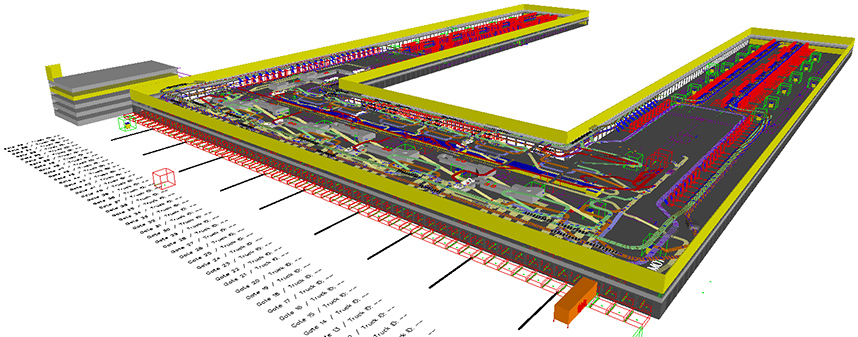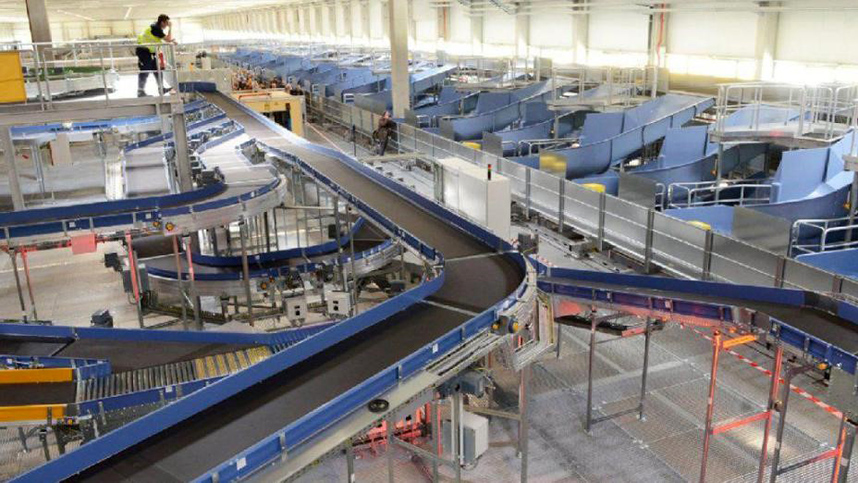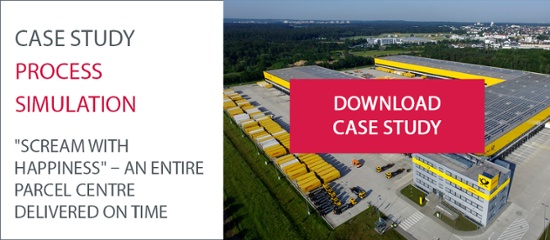The more complex a planned production plant or factory is, the more you have to keep an eye on all decisive factors such as time, costs, quality and processes. But no matter how well you plan and control everything, unforeseeable errors and bad investments can still occur.
Process simulation is a decisive networking element for smart factory solutions. The processes of complex production systems can be digitally mapped and extensively tested before commissioning.
A process simulation supports you in all phases of the implementation of your new project – from conception, through detailed planning to commissioning. All you need is an existing plant or planning on the basis of which all available data is integrated into a simulation model.
Shaping the future BEFORE.
In the early project phase, all information and the entire know-how of all those involved in the project are combined in the simulation model in order to already secure the concept planning.
Every project manager strives to implement his project as successfully as possible. If, for example, you are planning a conveyor system, many different areas have to interlock simultaneously in order to function faultlessly in the end and produce the desired output. Be it the material flow, which determines the layout of the plant, or the control system, which in turn must guarantee the functionality of the material flow.
With the help of the created model, which depicts the complete planned plant, investigations on the layout or optimisations in the control system can be determined and different scenarios can be examined. The process simulation brings all involved areas together at one table and shows at an early stage how the plant must be designed. This avoids over- or underdimensioning, which leads to additional costs and possibly a cost-intensive delay of the entire project.
By recording all relevant areas and processes, you get a precise overview of the interaction of all topics important for the project, such as output, throughput rates, utilization, buffer sizes or even throughput times.
Even if you want to make adjustments or changes to, for example, your production line in a few years' time in order to expand it or switch to a new product, you can use this simulation model as a basis for setting up the system again. You can consult the old simulation model almost like a blueprint. Because the real plant is available as a digital twin, you can simulate changes or adjustments to your existing plant with it already during the conversion planning and do not have to stop the running operation of the real plant. Here the models can also be coupled with a manufacturing execution system to be supplied with the current data of the plant.
Virtual commissioning as a preliminary stage to real commissioning
The virtual commissioning of a plant allows the decoupling of hardware and software development. By replacing the simulated controllers in the model with real controllers, a virtual commissioning environment is created which can be used to detect and eliminate errors in the control software at an early stage. This procedure improves the quality of the control software and thus saves time and costs during commissioning in the real plant.
For virtual commissioning, the EDAG simulation models are coupled with the customer's control computers to test the software already programmed. This means that the control computer does not communicate with the real plant, but with the model. It does not notice the difference This allows you to see exactly on the model whether the control reacts correctly or whether the software needs to be programmed differently.
EDAG Production Solution supports the development and implementation. We even ship shoes.
Large conveyor systems, such as those used by DHL in its parcel centres, are highly complex and generate high transport volumes. Deutsche Post DHL Group was faced with the challenge of responding to the increased demands that customers place on the logistics services of Amazon & Co. in addition to a huge range of products when shopping online with a new, particularly efficient parcel centre. Same day or overnight deliveries are often an important criterion for the order, which logistics must provide The goal: Instead of the previous maximum of 40,000 parcels per hour, new centres should make it possible to sort 50,000 parcel shipments per hour.

Given the high planned capacity and intensive logistics of this huge facility, DHL needed an innovative process simulation solution for the construction of the new high-tech parcel centre in Obertshausen to ensure a smooth and punctual start-up. To this end, the EDAG Group’s Simulation and Production IT departments created a flexible emulation environment, which can be used both for simulation and for virtual commissioning.
On the basis of standard software, all conveyors and controls of the entire plant are mapped. With the help of simulation, the performance of the system can be determined and optimised – for example, with regard to the sorting speed for a previously defined quantity of parcels.
Control programming and construction of the plant can be carried out in parallel
The flexible emulation environment can also be used for virtual commissioning. The control logics used in the simulation can be switched off. Instead, the real controls of the control system, the material flow computer and the PLC are coupled to the simulation model. This makes it possible to check whether everything actually works as planned – or whether adjustments are still necessary in the control programming.
The advantage is that the construction of the system and the programming of the controller can be advanced in parallel as incremental processes of a Scrum project. This shortens the development time, increases the software quality and at the same time enables faster commissioning.

Thanks to the flexible emulation environment of EDAG Production Solutions, it was possible to implement a particularly powerful package conveyor system. Source: Deutsche Post DHL Group
Process simulation for all cases
The fields of application for process simulation are very diverse and there are hardly any industries or applications for which it could not be used:
- For the optimisation of business processes, control systems and material flows over the entire production life cycle: The application in all project phases helps in decision-making processes to find customised, investment-optimised concepts.
- For checking extreme scenarios and defining suitable measures without influencing ongoing processes.
- For supplementing user interfaces and interfaces to production systems for ongoing operation.
Our tasks include the analysis, optimisation and dimensioning of
- Plant structures and decoupling parameters
- Processes and process times
- Sequencing and resource planning
- Warehouse stocks / delivery reliability
- Capacity shortage analyses with alternative solutions
Our target is always to take a holistic view of the process, resources, logistics and material flow:
- Improvement of system comprehension
- Development of the highest possible potential value
- Control of complex systems
- Absolutely reliable forecasts
EDAG Production Solutions offers complete solutions for sustainable production systems and is the perfect interface between product development and plant engineering.
With our four locations we are close to our customers and our team of 23 simulation experts deals exclusively with the topic of process simulation. Our claim is always a customer-oriented project handling, but of course also user-friendly and flexible simulation models.
We have more than 20 years of experience in a wide range of industries: be it the semiconductor industry, airport baggage & cargo industry, aviation industry, food or beverage industry, intralogistics or in the automotive and supplier sector.
All a game? No, it’s not! Simulation is a great tool to collaborate objectively and result-oriented with all parties involved in the planning process. Together we can open up the complexity of your production and optimise systems.
Ingo Rosteck is head of process simulation at EDAG Production Solutions and has been with the company since 1994. He is always looking forward to new projects and challenges, which he can solve through the targeted use of process simulation and will be happy to discuss your very special application with you.
Download our case study now and benefit from our many years of industry expertise as a production solutions partner.






